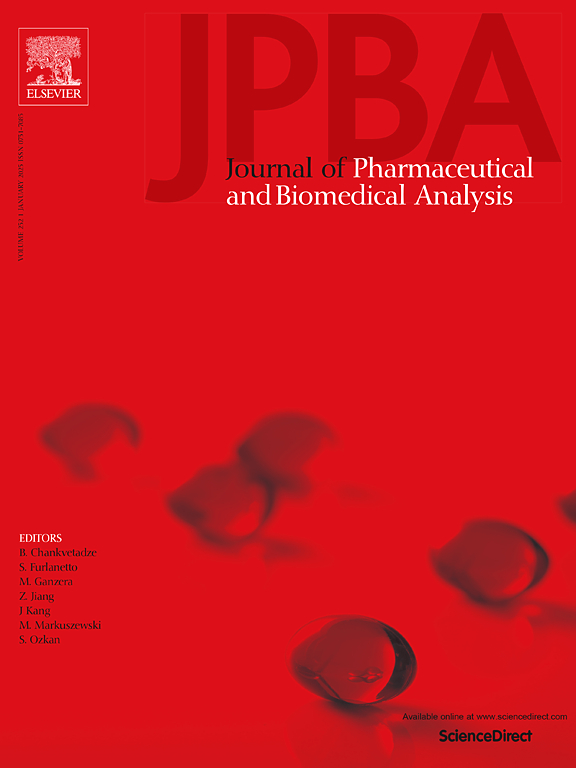代谢组学揭示了在肝损伤中,红草介导的能量恢复和精氨酸代谢
IF 3.1
3区 医学
Q2 CHEMISTRY, ANALYTICAL
Journal of pharmaceutical and biomedical analysis
Pub Date : 2025-05-14
DOI:10.1016/j.jpba.2025.116955
引用次数: 0
摘要
全球急性肝损伤发生率持续上升,对公众健康构成重大威胁。虽然生的和加工过的林奈野樱草(RI)都显示出保护肝脏的特性,但其机制需要进一步阐明。本研究采用UPLC-Q-TOF/ ms为基础的血清代谢组学,描绘了在急性肝损伤小鼠模型中,生的和加工的RI的不同的肝脏保护机制。在给小鼠灌胃低、中、高剂量的生的和加工的RI提取物10天后,小鼠腹腔注射50% %四氯化碳橄榄油。采用ELISA法测定血清天冬氨酸转氨酶(AST)、丙氨酸转氨酶(ALT)、碱性磷酸酶(ALP)水平,以及肝脏超氧化物歧化酶(SOD)、丙二醛(MDA)、羟脯氨酸(Hyp)水平。采用苏木精和伊红(HE)染色、马松染色和天狼星红染色检查肝脏组织病理学。与模型组相比,粗RI和加工RI均显著降低血清AST、ALT和ALP水平,同时降低肝脏MDA和Hyp含量。相反,SOD活性明显升高。代谢组学分析在模型组中发现了39种显著改变的内源性代谢物,随后分别在原料组、盐处理组和酒处理组中鉴定了22种、23种和7种不同的生物标志物。这些生物标志物主要与能量代谢和精氨酸代谢有关。此外,RI中的酚类和类黄酮化合物以其抗炎和抗氧化特性而闻名,在减轻CCl 4引起的肝损伤中发挥了关键作用。这些发现提供了强有力的证据,支持在开发保护肝脏的保健产品中使用原始和加工的RI。本文章由计算机程序翻译,如有差异,请以英文原文为准。
Metabolomics uncovers Rubus idaeus-mediated recovery of energy and arginine metabolism in liver injury
The global incidence of acute liver injury continues to rise, posing a significant threat to public health. While both raw and processed Rubus idaeus Linnaeus (RI) demonstrate hepatoprotective properties, their mechanisms require further elucidation. This study employed UPLC-Q-TOF/MS-based serum metabolomics to delineate the distinct liver-protective mechanisms of raw and processed RI in a murine model of acute liver injury. Following ten days of intragastric administration with low, medium, and high doses of raw and processed RI extracts, mice received intraperitoneal injection of 50 % carbon tetrachloride in olive oil. Serum levels of aspartate transaminase (AST), alanine transaminase (ALT), and alkaline phosphatase (ALP), as well as liver levels of superoxide dismutase (SOD), malondialdehyde (MDA), and hydroxyproline (Hyp), were measured via ELISA. Liver histopathology was examined using Hematoxylin and Eosin (HE), Masson, and Sirius Red staining. Treatment with both raw and processed RI significantly reduced serum AST, ALT, and ALP levels while decreasing hepatic MDA and Hyp content compared to the model group. Conversely, SOD activity showed marked elevation. Metabolomic profiling identified 39 significantly altered endogenous metabolites in the model group, with subsequent characterization of 22, 23, and 7 distinctive biomarkers in the raw, salt-processed, and wine-processed RI treatment groups, respectively. These biomarkers predominantly associated with energy metabolism and arginine metabolism. Furthermore, the phenolic and flavonoid compounds in RI, known for their anti-inflammatory and antioxidant properties, played a key role in mitigating liver damage induced by CCl₄. These findings provide strong evidence supporting the potential use of both raw and processed RI in the development of hepatoprotective health products.
求助全文
通过发布文献求助,成功后即可免费获取论文全文。
去求助
来源期刊
CiteScore
6.70
自引率
5.90%
发文量
588
审稿时长
37 days
期刊介绍:
This journal is an international medium directed towards the needs of academic, clinical, government and industrial analysis by publishing original research reports and critical reviews on pharmaceutical and biomedical analysis. It covers the interdisciplinary aspects of analysis in the pharmaceutical, biomedical and clinical sciences, including developments in analytical methodology, instrumentation, computation and interpretation. Submissions on novel applications focusing on drug purity and stability studies, pharmacokinetics, therapeutic monitoring, metabolic profiling; drug-related aspects of analytical biochemistry and forensic toxicology; quality assurance in the pharmaceutical industry are also welcome.
Studies from areas of well established and poorly selective methods, such as UV-VIS spectrophotometry (including derivative and multi-wavelength measurements), basic electroanalytical (potentiometric, polarographic and voltammetric) methods, fluorimetry, flow-injection analysis, etc. are accepted for publication in exceptional cases only, if a unique and substantial advantage over presently known systems is demonstrated. The same applies to the assay of simple drug formulations by any kind of methods and the determination of drugs in biological samples based merely on spiked samples. Drug purity/stability studies should contain information on the structure elucidation of the impurities/degradants.

 求助内容:
求助内容: 应助结果提醒方式:
应助结果提醒方式:


